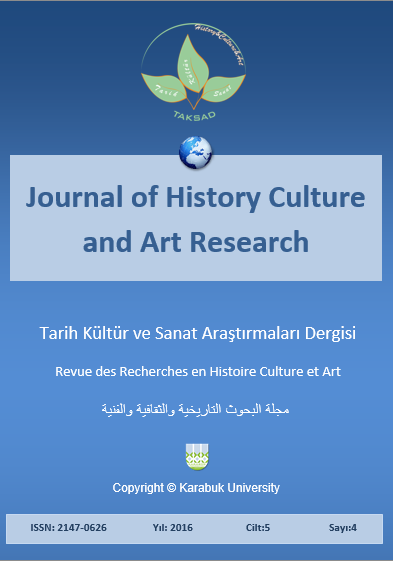Shu'ubiyya Thoughts of Muwallads in Andalusia: The Causes and Contexts
DOI:
https://doi.org/10.7596/taksad.v5i4.589Keywords:
Umayyad Andalusia, Muwallads, Arabs, Shu'ubiyya, Saqaliba, Ibn Garcia.Abstract
Abstract
Muwallads (native neo-Muslims) were one of the groups that played an important role in political and social changes during the reign of the Umayyads of Andalusia. By conversion to Islam, they called for equal rights with the Arab minority. However, political exclusion, poverty, and economic pressure, social and racial discrimination applied against them by the Arab Umayyad rulers provided the context of their rebellion. Initially, most Muwallads began military struggle against the reign to obtain their rights. The conditions almost changed by the beginning of the third Abul Al-Rahman’s governance (imprinted, 912-961 AD), and the peaceful politics as well as ethnic and religious tolerance of Abdul Nasser, the Umayyad caliph and his son, the second sentence (imprinted; 961-972 AD) made opportunities for Muwallads to participate in political and social structures of Andalusia society. However, in the meantime, some of them emphasizing their ethnic identity did cultural and intellectual activities in the form of praising and advocating talent and ability of non- Arab against Arabs’ racial prejudice and racial superiority. In addition, gradually, with the weakness of the Umayyad rule in Andalusia and the formation of independent states, the defensive mode changed into offensive and explicit denial of the Arab’s race by the Muwallads that culminated in the Shu’ubiyya treatise of Ibn Garasiah.
Using an analytical approach, this article is intended, first, to examine the causes and context of the formation of Shu’ubiyya thoughts in Andalusia and then to survey the method and quality of writing treatises and writings of Shu’ubiyya at the end of Umayyad rule.
References
Al-Azzawi, N. R. (1982). Articles in Effect of Shu'ubiyya in the History and Literature of Arab. Baghdad.
Al-Hariri, I. (1982). Muwallads, Movements in the Southern Andalusian in the era of the Umayyad in Andalusia. Yemen.
Atwan, H. (No date). Heterodoxy and Shu'ubiyya in the First Abbasid Era. Beirut: Daraljyl.
Ebadi, M. (1903). Saqaliba in Spain, Cairo.
Farrukh, U. (1984). Literature in Morocco and Andalus since the Islamic Conquest to end the Era of Feudalism. Beirut: Dar al ilm al Byyn.
Gumzman, R. M. (1995). “The end of the Revoit of ibn in Al- Andalus, The Period of Abdal – Rahman (912-928)”, Islamic Studiea 34.
Haron, A. S. (1991). “Shu'ubiyya of Muslims in Spain”, Rare Manuscripts, Volume 1. Madrid.
History of Andalusia, (1983). Madrid: Research of Luis Molina.
Hitchcock, R. (Ashgate e- book). Mozarabs in Medieval and Modern Spain.
Homayran, (1975). Abu Abdullah Muhammad Ibn Abdel-Al-Almtarfy No Alaqtar. R Abbassi, Beirut.
Ibn al-Khatib, (1956). Lesan-Din. Beirut: Business Media, Print Pruvansal Levy.
Ibn Bassam Abul Hasan Ali Ibn Bassam Shantryny, (1966). Ammunition of Pros of Island Folks. R Abbassi, Beirut.
Ibn Hayyan, (1973). Excerpt, Research of Mahmoud Mekki. Beirut.
Ibn Hayyan, (1973). Abumarvan, Quoted in the History of Andalusia Men, Volume III. Paris: Antvna Publisher.
Ibn Hazm, (1983). Crowd of Generations of Arabs. Beirut.
Ibn al-Qūṭiyya, (1989). Abu Bakr Muhammad, History of Triumph of Andalusia. Cairo: Research Ibrahim Irrigation.
Ibn Uzra Abul Abbas Ahmad, (1983). The Statement of Morocco in Andalusia and Morocco News, Volume II. Beirut: Published Levi Pruvansal.
Imamuddin, S. M. (1981). Muslim Spain 711-1492 A.D.A Sociological Study Medival Iberian Peninsula. Brill Academic.
Khashna, A. (No date). Judges of Cordova, a research of Ibrahim Abyari. Cairo: Dar al-Kitab al-Masri.
Larsson, G. (2003). Ibn Garcia Shuubiyya Letter, Ethnic and Theological Tension in Medieval al-Andalus. Leiden.
Momtahen, A. (1992). Shu’ubiyya Movement, the National Iranian Resistance Movement Against the Umayyad and Abbasid Caliphate. Tehran: Corporation of Paperback Book.
Monroe, J. T. (1970). Monroe, the Shu’ubiyya in Al-Andalus, The Risala of Ibn Garcia and Fiue Refutations. Berkeley, Los Angeles & London. pp.23-29.
Ozra, Ahmed Ben Asr, (1965). News Setting, Research of Abdulaziz Alahvany. Madrid.
Palensya, A. (1334 BC). History of Andalus Thought, Moved from Spain. (Hussein Mvnys). Cairo: Mktbh Alsqafh Aldynyh.
Qadureh, Z. (1987). Shu'ubiyya and Social and Political Impact in the Lives of Islamism in the First Abbasid Era. Beirut: School of al Islami.
Samera'i, Khalil Ebrahim Saleh, (1976). Top Andalusian Tears. Baghdad.
Zby, A. (1984). In Order to Petitioner. Madrid.
Zeif, S. (1989). History of Arabic Literature, The Era of Nations and the United Arab Emirates of Andalus. Cairo: Dar al Marf.
Zeif, S. (No date). Abbasi Era. A Research of al-Qirbi, Qom.
Znvn. Taha, Abdul Wahid, (2004). Studies in the Andalusian Culture and the History. Beirut: Dar al Almdar.
Znvn Taha, Abdul Wahid, (2004). Arab Conquest and Stability. Beirut: Dar al Almdar.
Downloads
Published
How to Cite
Issue
Section
License
All papers licensed under Creative Commons 4.0 CC-BY.- Share — copy and redistribute the material in any medium or format
- Adapt — remix, transform, and build upon the material for any purpose, even commercially.
Under the following terms:
Attribution — You must give appropriate credit, provide a link to the license, and indicate if changes were made. You may do so in any reasonable manner, but not in any way that suggests the licensor endorses you or your use.
- No additional restrictions — You may not apply legal terms or technological measures that legally restrict others from doing anything the license permits.







